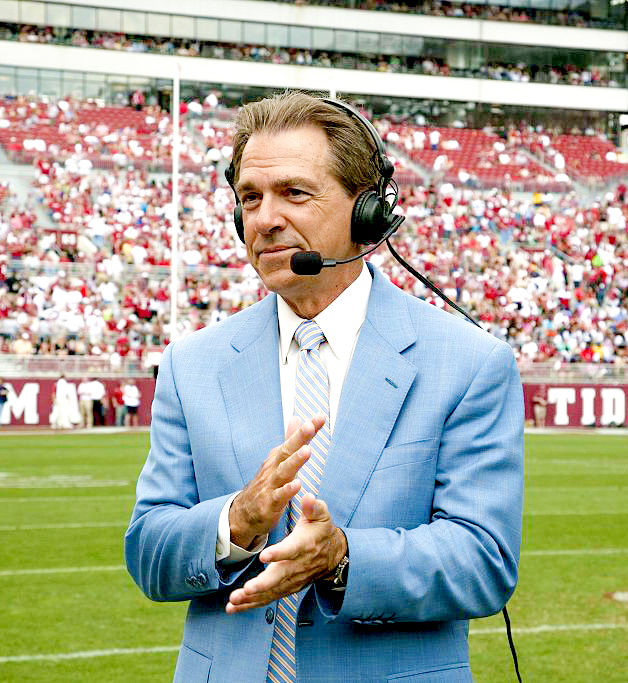Few names resonate as profoundly in college football as Nick Saban. With seven national championships, six of them at the University of Alabama, Saban stands among the sport’s all‑time legends as.com+14apnews.com+14facebook.com+14. Yet nothing in his record-setting career prepared fans, players, and the broader collegiate world for the seismic shift announced this week: Alabama has appointed its former head coach as Athletic Director, marking an unprecedented transition in the annals of Alabama athletics. From his arrival in Tuscaloosa in January 2007, Saban’s impact was unmistakable. An eight-year, multimillion-dollar contract marked his arrival as one of the highest-paid coaches in college football en.wikipedia.org+1espn.com+1. What followed was nothing short of academic and athletic revolution: in 17 seasons, he amassed a staggering 201–29 on-field record, six SEC titles, nine SEC West crowns, and six national titles—culminating in an iconic dynasty that reset standards in NCAA football en.wikipedia.org.
Under Saban’s stewardship, Alabama’s presence at the summit was nearly absolute: his teams were AP poll-ranked No. 1 at some point each season from 2008 to 2023. His leadership also shepherded four Heisman Trophy winners—the most by any coach coaching at multiple positions—along with 47 All-Americans sports.yahoo.com+15rolltide.com+15reddit.com+15. More than X’s and O’s, Saban instilled a “process” ethos, adapting offensive structures (e.g., embracing the spread) and reinforcing discipline, academic achievement, and character in his players .
The Retirement: A Monumental Shift
On January 10, 2024, Saban stunned the collegiate landscape by announcing his retirement at the end of a brief team meeting espn.com+3alabama.rivals.com+3espn.com+3. At age 72, he acknowledged that long, demanding days had become more challenging, further influenced by the evolving nature of college football—specifically in areas like the transfer portal and NIL compensation sports.yahoo.com+14espn.com+14espn.com+14.
Within hours, Alabama’s Athletic Director, Greg Byrne, prepared to execute a plan years in the making. Byrne had been in conversation with Saban since 2022 about a possible end to his coaching era. True to his word, Byrne delivered: just 49 hours post-announcement, Alabama secured Kalen DeBoer—then head coach at the University of Washington—as Saban’s successor sports.yahoo.com+8alabama.rivals.com+8espn.com+8.
Transition from Coach to AD: A Strategic Masterstroke
In March 2024, Alabama’s Board of Trustees formalized Saban’s transition from coaching to administration. He assumed duties as Athletic Director, tasked with guiding the athletic department’s vision—spanning football, Olympic sports, NIL initiatives, student-athlete welfare, gender equity, and beyond .
Multiple outlets reported Saban took office at Bryant‑Denny Stadium; in fact, the playing surface was renamed Saban Field earlier that fall en.wikipedia.org. He now maintains a $500,000 salary in his advisory/administrative role, continuing to have a profound presence in the university’s athletic ecosystem .
What This Means for Alabama Athletics
1. Unparalleled Athletic Prestige
Saban’s new role solidifies Alabama’s unwavering dedication to producing excellence within and beyond the football program. His credibility reinforces Alabama’s dominance but now cloaked in a position that influences the entire athletic department.
2. Continuity in Football Leadership
Saban’s involvement ensures tight alignment between the athletic director’s office and football operations. This continuity means no strategic drift for the program under DeBoer; instead, a seamless handoff backed by Saban’s authority and mentorship.
3. NIL and the Modern Athlete
Greg Byrne and Saban acknowledge the changing collegiate sports landscape. Saban’s administrative role amplifies Alabama’s ability to navigate Name, Image, and Likeness (NIL) complexities and investor-market dynamics tied to player branding .
4. Expanded Focus on Olympic Sports
With Saban’s reputation and administrative clout, non‑football sports—like gymnastics, track, and softball—may see stronger fundraising, access to premium facilities, and enhanced national exposure.
5. Gender Equity and Student-Athlete Welfare
Byrne’s public discussions (including recent interviews) highlight proactive equity programming—particularly female student-athlete support—suggesting Saban will champion those initiatives too en.wikipedia.org+9athleticdirectoru.com+9youtube.com+9.
Byrne’s Succession Planning: A Master Administrator
Greg Byrne, Athletic Director since 2017, stands at the heart of the transition espn.com+4alabama.rivals.com+4southernliving.com+4. A veteran AD (Oregon, Kentucky, Mississippi State, Arizona), Byrne executed foresight by preparing a succession blueprint early in Saban’s tenure. That plan—devised after a 2022 conversation—culminated in a rapid and disciplined transition .
Byrne’s approach reinforces a seldom-discussed aptitude: identifying future-ready talent and giving administrators time to prep, usher in change, and frame smooth cultural shifts—all without alienating stakeholders.
Introducing Kalen DeBoer: The Next Football Leader
In the intense 49-hour coaching search that followed Saban’s retirement, Kalen DeBoer rose to the top—and was hired cbssports.com+6espn.com+6apnews.com+6. The 49-year-old brought with him a 67–3 NAIA record at Sioux Falls, a winning stint at Fresno State, and transformative success at Washington, including a national championship appearance and a Pac‑12 title apnews.com.
Byrne underlined his focus on character, stating DeBoer cares about players “like I’d want my sons to play for”—qualities Alabama values deeply apnews.com. While DeBoer inherits daunting benchmarks, his rapid recruitment, confidence from players, and offensive excellence suggest he could build on Saban’s formidable legacy.
A Historical Comparison
Alabama’s previous storied eras include coaches like Bear Bryant and athletic directors such as Mal Moore, each shaping different eras. But never before has a head coach ascended to athletic director immediately after coaching retirement en.wikipedia.org+1en.wikipedia.org+1.
This marks a bold new model: using coaching legend to bolster departmental leadership. Few programs can replicate this schema, which bridges coaching excellence with strategic bureaucratic leadership
Cultural and Institutional Impact
For Coaches and Staff
Saban’s new role creates internal synergy and may attract top-tier coordinators and assistants who see mentorship opportunities and a chance to be part of a broader vision.
For Fundraising and Philanthropy
Alabama’s booster network will likely deepen its support, with Saban’s involvement offering compelling invitations for capital campaigns, facility expansions, and name brand development.
For Recruits and NIL Partners
Prospects now view Alabama as a mature, cutting-edge institution adept at balancing player visibility, marketplace savvy, and intense athletic development—all guided by Saban’s presence.
For Rival Programs
Alabama’s structural pivot forces high-performing programs nationwide to rethink departmental leadership models. Success in football is no longer enough—it must be broadly embedded in athletic pipelines and administration.
Challenges Ahead
-
Maintaining Transparency and Authority: Defining Saban’s role without muddling Byrne’s mandate will be critical. Clear operational structures and reported governance are essential to avoid organizational confusion.
-
Sustaining Football Dominance: As DeBoer steps in, pressure to win remains immense. Alabama must support him with continuity in recruiting, staff stability, and internal development pipelines.
-
NIL Complexity: Player agency changes require bold strategy; success here may define Toledo programs in the next decade. Saban and Byrne must blend market agility with institutional values.
-
Olympic Sports Growth: Beyond football, Alabama’s other programs deserve elevated investment. Saban’s impact on departmental unity must translate to equitable emphasis for all sports.
Looking Forward
Saban’s new job title speaks volumes—but his likely impact will transcend semantics. We can anticipate:
-
Upgraded athletic facilities (especially basketball, gymnastics, swimming).
-
Innovative academic-athletic partnerships that cement athlete success off the field.
-
Enhanced NIL platforms, from branding education to legal resources
Nick Saban’s transformation from football architect to athletic architect offers Alabama an unparalleled advantage and signals a shift in college sports leadership models. His credentials—as a coach, motivator, disciplinarian, and now institutional leader—introduce a new archetype: a coaching legend who morphs into a long-term policymaker and advocate.
The success of this strategy hinges on roles clarity and integration. If Alabama blends Byrne’s administrative acumen, Saban’s brand equity, and benefits from DeBoer’s fresh energy, the Crimson Tide may just redefine not only SEC benchmarks, but national models for athletic leadership.
Alabama knows how to win. Now, it’s learning how to lead in every sense of the word. And it’s doing so with one of its greatest ever at the organizational helm—this time, steering the ship from the front office rather than the sideline.



